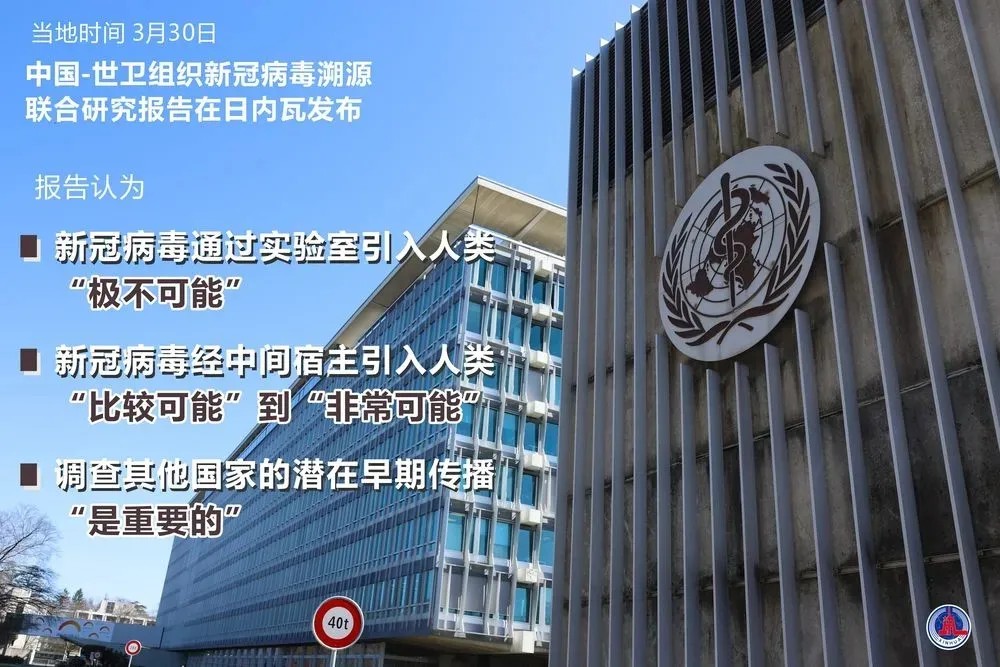WHO: Lab Introduction of COVID-19 into Humans Is “Extremely Unlikely”

Open the phone and scan
A joint WHO-China study report on the origins of COVID-19 was released in Geneva on March 30. According to the report, COVID-19 introduction through a laboratory incident is "extremely unlikely”, introduction through an intermediate host is "likely to very likely," direct introduction through animals is “possible to likely”, and introduction through cold/food chain products is "possible”.

The expert team reviewed data from published studies from different countries suggesting early circulation of COVID-19, according to the report. The findings showed that the positive samples were weeks earlier than the initially detected cases, and some of the positive samples were detected even earlier than the first case in Wuhan, suggesting the possibility of circulation in other countries. The quality of such studies is still limited at present, but it is important for investigating the potential circulation of COVID-19 in early stages.
From January 14 to February 10 this year, a joint expert team of 17 Chinese experts and 17 foreign experts, divided into 3 groups: epidemiology, molecular tracing, and animals & environment, conducted the Chinese part of the global origin tracing study in Wuhan for 28 days, on the basis of which the study report was written.

Entrance of the headquarters of the World Health Organization (WHO) in Geneva, Switzerland, March 30.
(Photo by Chen Junxia/Xinhua)
They made assessment of the likelihood of possible pathways of COVID-19, and concluded that, COVID-19 introduction through an intermediate host is "likely to very likely," direct introduction through animals is “possible to likely”, introduction through cold/food chain products is "possible”, and introduction through a laboratory incident is "extremely unlikely”.
The report also put forward a series of recommendations for future researches: developing a global comprehensive database, searching for possible early cases in broader areas of the world, looking for possible animal hosts in various countries and regions by global scientists, and further understanding the role of the cold chain and frozen foods in the possible spread of the virus.

Entrance of the headquarters of the World Health Organization (WHO) in Geneva, Switzerland, March 30.
(Photo by Chen Junxia/Xinhua)
The WHO held a member state briefing on the report. Peter Ben Embarek, head of the foreign experts in the joint team, introduced the team's field work and joint research in Wuhan and thanked the Chinese government and scientists for their support for the collaboration on the origin tracing.
Liang Wannian, head of the Chinese experts, said that the report is the result of joint efforts of both Chinese and foreign experts. The joint expert team always upheld scientific thinking and conducted research cooperation based on evidence. The COVID-19 origin tracing research in China is part of the global study of origins of the virus, and it is the first step. All the conclusions and recommendations in the report are based on a global perspective, and future research will not be limited to a certain area.

The headquarters of the World Health Organization (WHO) in Geneva, Switzerland, March 30.
(Photo by Chen Junxia/Xinhua)
Ambassador Chen Xu, Permanent Representative to UN office in Geneva, said that Chinese experts and the international experts of WHO showed a scientific and open spirit. The Chinese government at all levels provided the necessary assistance for the work of the expert team in Wuhan, fully reflecting the open, transparent and responsible attitude of the Chinese side, which was also highly appreciated and fully affirmed by experts from both sides.
Novel coronavirus origin tracing is about science, and it should be jointly carried out by scientists worldwide. Novel coronavirus origin tracing is also a global mission. This joint WHO-China study will play a good role in promoting origin-tracing in many countries and regions around the world, offer positive and useful guidance, and provide a scientific guide for the human race to better understand the virus.


